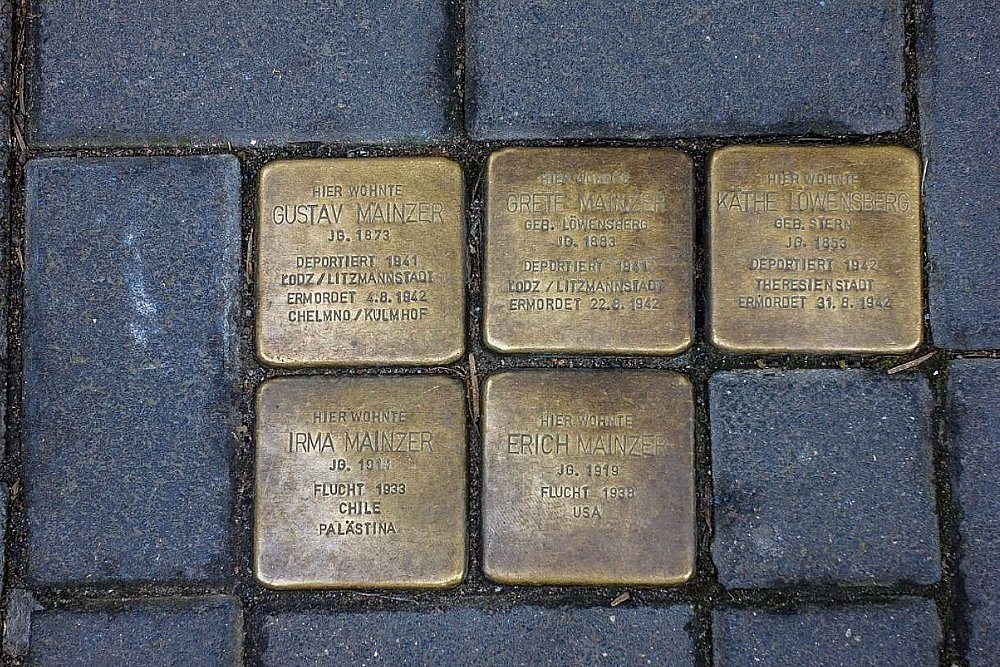Stumbling Stones Windmühlstraße 5
These small, brass plaques (Stolpersteine or stumbling stones) commemorate:
* Gustav Mainzer, born 1873, deported 1941, Lodz/Litzmannstadt, murdered 4 August 1942, Chelmno/Kulmhof.
* Grete Mainzer née Löwensberg, born 1883, deported 1941, Lodz/Litzmannstadt, murdered 22 August 1942.
* Käthe Löwensberg née Stern, born 1853, deported 1942, Theresienstadt, murdered 31 August 1942.
* Irma Mainzer, born 1911, fled 1933, Chile, Palestine.
* Erich Mainzer, born 1919, fled 1938, USA.
Background
Gustav Mainzer had a son, Otto, with his first wife, Greta Löb. She died when the boy was six.
Now a widower, Gustav married Grete Löwensberg in December 1910. They had a daughter, Irma, in 1911. They moved to Windmühlstraße 5 in 1916, and three years later son Erich was born. Grete’s mother, Käthe Löwensberg, joined the family sometime in the 1920s. Gustav had a shop selling hats, white goods, and woolens. He also made and sold lingerie. But in the 1930s, the boycott of Jewish businesses led to declining sales. Daughter Irma fled from Germany to Chile in 1933 and eventually settled in Israel. In August 1938 son Erich fled to the USA and became an electrical engineer. Son Otto Mainzer had become a lawyer who, in 1933, was banned from his profession. He fled to the USA in 1941 and became a writer.
Gustav and Grete Mainzer remained in Germany. After the Reichspogromnacht in November 1938, he had to close his shop. He and Grete were deported to Lodz on the same day in October 1941. After their deportation, her mother, Käthe Löwensberg, was admitted to a Jewish hospital, which became a retirement home. She was deported to Theresienstadt in August 1942 and was dead 2 weeks later. Gustav and Grete were also murdered in that same month: they were each taken from Lodz to the Chelmno extermination camp.
"Stolpersteine" is an art project for Europe by Gunter Demnig to commemorate victims of National Socialism (Nazism). Stolpersteine (stumbling stones) are small, 10x10cm brass plaques placed in the pavement in front of the last voluntary residence of (mostly Jewish) victims who were murdered by the Nazis. Each plaque is engraved victim’s with the name, date of birth, and place (mostly a concentration camp) and date of death. By doing this, Gunter Demnig gives an individual memorial to each victim. One stone, one name, one person. He cites the Talmud: "A human being is forgotten only when his or her name is forgotten."
Do you have more information about this location? Inform us!
Source
- Text: Anne Palmer
- Photos: Sascha Stefan Ruehlow
- Stolpersteine Frankfurt: Familien Loewensberg & Mainzer
- Stolpersteine.eu
Nearby
Point of interest
- Air-Raid Shelter Friedberger Anlage - Frankfurt am Main
- House Anne Frank - Frankfurt am Main
- Frank Family House - Frankfurt am Main
Monument
- War Memorial Frankfurt am Main - Frankfurt am Main
- Memorial Victims National-Socialism - Frankfurt am Main
- Memorial Book Burning - Frankfurt am Main
Cemetery
- German War Graves Hauptfriedhof Frankfurt - Frankfurt am Main
- Mass Grave Concentration Camp Victims Frankfurt - Frankfurt am Main
- Soviet War Graves Hauptfriedhof Frankfurt - Frankfurt am Main





